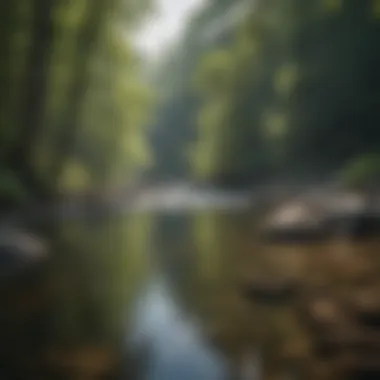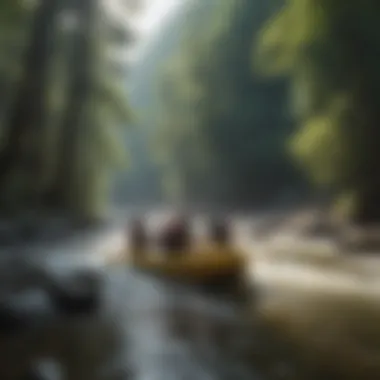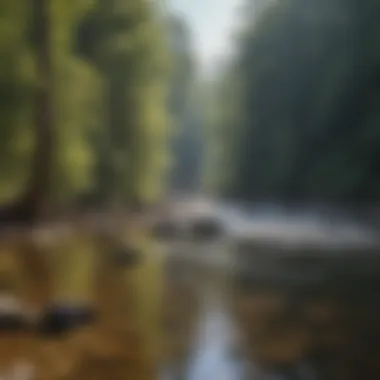Exploring the Chattooga River: A Guide to Whitewater Adventures


Intro
The Chattooga River is a jewel of the southeastern United States. It flows through parts of Georgia, South Carolina, and North Carolina. This river is not only significant due to its natural beauty, but it also attracts those seeking adventure through whitewater rafting. The Chattooga is recognized as one of the top destinations for rafting, offering captivating experiences for both new and seasoned paddlers. This guide aims to unfold the various aspects of the Chattooga River, from its history and ecology to the thrills of navigating its rapids.
Understanding Woodland Ecosystems
The Chattooga River is surrounded by rich and diverse woodland ecosystems. These forests contribute significantly to the overall health of the river and its surroundings. The importance of biodiversity in forests cannot be overstated. Biodiverse ecosystems provide habitat for numerous species. They maintain ecological balance and promote resilience against diseases and climate shifts.
Additionally, forests play a crucial role in climate regulation. They act as carbon sinks, helping mitigate climate change impacts while supporting local weather patterns. The ample tree cover along the banks of the Chattooga not only stabilizes the soil but also provides shade to the waters. This shading is essential as it maintains lower water temperatures critical for aquatic life. Understanding these dynamics elevates the appreciation of the Chattooga River beyond its thrilling rapids.
Sustainable Recreation Practices
Whitewater rafting, while exciting, brings environmental responsibilities. Sustainable recreation practices must be observed to protect the fragile ecosystems surrounding the river. It’s vital for rafters to follow Leave No Trace principles. These guidelines help minimize human impact on the natural environment.
Key principles include:
- Plan Ahead: Understanding the river’s conditions and regulations.
- Travel and Camp on Durable Surfaces: Staying on established trails lessens soil erosion.
- Dispose of Waste Properly: Pack out all trash and human waste.
By engaging in sustainable practices, adventurers can enjoy the Chattooga River without compromising the unique ecosystems associated with it.
Community Engagement in Conservation Efforts
Local communities play a vital role in the conservation of the Chattooga River. Volunteer organizations and local agencies collaborate to monitor river health and promote awareness. Community-led initiatives focus on water quality testing and habitat restoration programs. Such efforts showcase the importance of public involvement in maintaining the river’s ecological integrity.
These groups not only work towards preserving the Chattooga but also educate visitors about respecting the environment. Knowledge sharing fosters a culture of conservation, ensuring the river remains pristine for future generations.
Culmination
The Chattooga River is more than just a destination for whitewater enthusiasts; it represents a complex interplay of ecosystems, community, and responsible recreation. Understanding its ecology, engaging in sustainable practices, and participating in conservation efforts are essential steps towards preserving this natural treasure. As you navigate its waters, remember the significance of the landscape that surrounds you.
Prelude to the Chattooga River
The Chattooga River, a prominent flowing waterway in the southeastern United States, stands out both for its recreational potential and its ecological significance. This section introduces the Chattooga River, highlighting its unique attributes and why it matters for enthusiasts and researchers alike. Understanding the river's geographical context and historical background enhances appreciation of its role as a natural resource and adventure destination.
Geographical Overview
The Chattooga River stretches over 57 miles, serving as a natural border between Georgia and South Carolina. The river originates in the Appalachian Mountains, specifically in the Chattahoochee National Forest. This mountainous terrain leads to swift currents and diverse landscapes. The river feeds into Lake Tugalo, a noteworthy reservoir that contributes to local hydroelectric generation.
The surrounding area includes rich forests, cascading waterfalls, and pristine wilderness, making the Chattooga River attractively situating for outdoor enthusiasts. The proximity to major highways, including U.S. Route 76, makes access relatively convenient for visitors.
Key features of the geographical landscape include:
- Cascades and Rapids: The river holds various rapids classified from Class I to Class V, appealing to both novice and expert rafters.
- Biodiversity: The Chattooga watershed supports diverse flora and fauna, resulting in a vibrant ecosystem.
- Recreation Sites: Several designated recreation areas are available, including places for camping, fishing, and hiking.
Historical Significance
The Chattooga River has a rich history that plays a role in the cultural and ecological narrative of the region. Early inhabitants utilized the river for sustenance and transportation, leading to settlement and interaction with indigenous tribes. By the mid-20th century, the river emerged as a destination for whitewater enthusiasts, influencing both tourism and conservation efforts.
In the 1970s, the Chattooga was designated as a Wild and Scenic River due to its outstanding natural characteristics. This designation aims to protect the river's wilderness and free-flowing conditions while allowing for public enjoyment.


The river's historical significance can be summarized as follows:
- Cultural Heritage: Indigenous tribes utilized the river long before European settlers arrived, highlighting the Chattooga's role in local history.
- Environmentally Significance: The river's status as a Wild and Scenic River reflects ongoing conservation efforts.
- Recreational Legacy: It has become a hub for outdoor activities, thereby contributing to local economies.
"Understanding the Chattooga's history is crucial. It connects us to the past and informs our responsibility to protect this resource for future generations."
Whitewater Characteristics
The Chattooga River is renowned for its whitewater conditions. Understanding these characteristics is essential for anyone who anticipates navigating its waters. The river's dynamic flow and diverse rapids create an exhilarating experience, but they also necessitate an appreciation for safety and skill. This section explores river classifications, ratings, and prime locations for both enjoyment and challenge.
River Classifications and Ratings
Whitewater rivers are classified on a scale from I to VI, indicating the difficulty of the rapids. The Chattooga River features various classifications, providing both beginners and seasoned rafters with suitable options.
- Class I: Simple rapids with minimal obstacles. Good for first-time rafters.
- Class II: Slightly more challenging, but manageable for novices with some guidance.
- Class III: Intermediate level. Requires a bit of skill and can present some hazards, suited for those who have some experience.
- Class IV: Advanced rapids with significant waves and drops. Actual proficiency in separate techniques is key.
- Class V: Expert-only sections that demand advanced techniques and quick decision-making. Not for the faint-hearted.
- Class VI: Unnavigable and unsafe under normal conditions. Reserved for extreme experts, if ever considered at all.
In the Chattooga, Class III and IV rapids dominate its stretch, illustrating a thrilling balance of excitement and danger. It is important for raft guides and participants to be familiar with these ratings before embarking on their journey.
Bridge and Rapid Locations
Identifying key bridges and rapid locations enhances the overall experience of traversing the Chattooga River. Notable spots along its course are crucial for planning trips and remain significant from a safety perspective.
- Key Bridges:
- Notable Rapids:
- Burrells Ford Bridge: A common starting point for many rafters. Provides access to some of the river’s most popular stretches.
- Ferguson Bridge: Offers stunning views and convenient access to Class III rapids.
- Bull Sluice: A prominent Class IV rapid known for its challenging drops and waves. Ideal for those seeking the thrill of extreme whitewater.
- Sockem Dog: Another Class IV rapid with demanding conditions, it requires skilled maneuvering.
Knowledge of bridge locations and rapids enriches the enjoyment of the river experience, offering participants the ability to strategize their descent and maximize safety.
Understanding the characteristics of the Chattooga River’s whitewater is crucial for ensuring an enjoyable and safe experience.
Safety and preparation are paramount when engaging with the river's powerful currents, which allows enthusiasts to appreciate its beauty without compromising their well-being.
Ecological Context of the Chattooga
The ecological context of the Chattooga River is vital for understanding its significance as a whitewater destination. This river supports a diverse array of plant and animal life, which contributes to the overall health of the ecosystem. The health of the river's environment also enhances the recreational experience for visitors, providing a backdrop of natural beauty that enriches activities like rafting and kayaking. Environmental factors play a key role in maintaining the quality of water and the integrity of the natural landscape.
Flora and Fauna
The flora and fauna along the Chattooga River area are key components of its ecological integrity. The river banks are lined with a variety of trees such as oaks, pines, and maples, creating a rich habitat for numerous species. Understory plants, including ferns and wildflowers, thrive in the moist conditions found in the shade of these trees.
Animal species abound as well. Birds such as eagles and herons are commonly spotted, while fish like rainbow trout and brook trout populate the waters. These species play a critical role in the local ecosystem, supporting food chains and contributing to biodiversity. In particular, the presence of top predator fish can indicate a healthy aquatic environment, signaling proper water quality and ecosystem balance.
Invasive species pose a challenge to the native flora and fauna. Controlling these species is necessary to protect the ecological balance. Programs and initiatives are underway in various local organizations to monitor and mitigate the impacts of these invaders.
Environmental Preservation Efforts
Numerous efforts are in place to preserve the ecological beauty of the Chattooga River. Local organizations work to promote conservation initiatives that focus on protecting habitats and restoring native species. Educating the public about the importance of these ecosystems is crucial for their sustainability.
Partnerships among local communities, volunteers, and environmental groups lead to cleanup events and habitat restoration projects. This engagement fosters a sense of ownership and responsibility among residents and visitors alike.


Additionally, regulations are enacted to limit pollution and manage river traffic, helping to mitigate human impact on the delicate ecosystems.
The federal government recognizes the Chattooga as a Wild and Scenic River. This designation provides extra protection against development and resource exploitation.
"The Chattooga River is not just a thrilling adventure spot; it is an ecological treasure that we must protect for future generations."
Recreational Activities
Recreational activities on the Chattooga River provide a multifaceted approach to experiencing its natural beauty and thrill. These activities are essential, as they attract visitors who seek both excitement and a deeper connection with the environment. Engaging in various water sports not only delivers recreational joy but also fosters a culture of conservation among enthusiasts. Understanding the available activities will enhance the overall experience for participants.
Whitewater Rafting
Whitewater rafting on the Chattooga is a highlight for many visitors. The river’s challenging rapids and stunning scenery create an unforgettable adventure. Rafting attracts a diverse crowd, from seasoned experts to beginners wanting to test their limits. It’s crucial for individuals to familiarize themselves with the safety protocols and proper gear before embarking on this journey. This ensures that everyone remains safe and enjoys their time on the water.
During a typical rafting excursion, participants navigate through various classes of rapids, experiencing everything from thrilling drops to calmer stretches ideal for relaxation. Professional guides are available to lead trips, imparting valuable knowledge about the river's dynamics and the ecosystem surrounding it. Such guided experiences not only prioritize safety but also enhance the educational aspect of the trip.
Kayaking and Canoeing
Kayaking and canoeing are also popular activities on the Chattooga River. These offer an alternative way to explore its serene and thrilling waters. Participants can choose from various routes based on their skill level, making these sports accessible to a wide audience. Kayaking allows for a more intimate interaction with nature, and paddlers can maneuver into serene coves and observe wildlife up close.
Canoeing, on the other hand, often lends itself to group trips where families or friends can paddle together. This communal aspect of canoeing contributes to strong social experiences and teamwork. Moreover, both activities encourage physical fitness and mental well-being through engaging outdoor exercise.
Fishing Opportunities
Fishing on the Chattooga River is another recreational aspect that should not be overlooked. The river supports a wide range of fish species, making it an attractive location for anglers. The tranquility of fishing allows for reflection and connection with nature, serving as a restorative practice for many.
It’s advisable for anglers to be aware of the local regulations regarding fishing seasons and licensing requirements. Many experienced fishermen recommend specific techniques and areas that yield better results. Additionally, conservation practices should be followed to maintain the river’s ecological balance. This includes catch and release methods that ensure fish populations remain sustainable for future generations.
Practical Considerations for Rafters
Understanding practical considerations for rafters on the Chattooga River is crucial for ensuring a safe and enjoyable experience. The river presents various challenges and opportunities, and being well-informed can significantly impact the outcome of your adventure. From safety measures to the appropriate season for rafting, each aspect plays a vital role in not only enhancing enjoyment but also safeguarding against potential hazards. The Chattooga River, known for its unpredictable currents and varying rapids, requires careful preparation and respect from all those who wish to navigate its waters.
Safety Guidelines
Prioritizing safety is essential for everyone participating in whitewater activities on the Chattooga. Recognizing and understanding potential risks can save lives. Here are key safety guidelines to follow:
- Wear a Personal Floatation Device (PFD): A properly fitted PFD should be worn at all times on the water.
- Know Your Limits: Assess your rafting skills honestly. Select sections of the river that align with your experience level.
- Stay Alert: Be aware of changing water conditions. Weather can impact water levels and rapids.
- Use Reliable Equipment: Ensure all gear, from paddles to helmets, is in good condition.
- Communicate: Establish a system of signals or cues among members of your group before embarking.
Safety guidelines are not just recommendations; they are essential practices that can protect you and your companions on the river.
Best Seasons for Rafting
The timing of your rafting trip can influence not only the conditions of the river but also the overall experience. The best seasons for rafting on the Chattooga River are generally dependent on water levels and weather patterns.
- Spring (March to May): This season often provides the best conditions for high-water rafting due to melting snow and rain runoff. However, this also means increased rapids and the need for greater skills.
- Summer (June to August): Water levels may stabilize, making it suitable for novice rafters. Hot weather makes this time popular for recreational activities.
- Fall (September to November): Autumn offers lower water levels and scenic foliage. It can be less crowded, appealing to those seeking solitude.
- Winter (December to February): Rafting is less common as cold temperatures and potential ice pose significant dangers.
Choosing the right season based on personal comfort and skill level enhances the rafting experience on the Chattooga River.
Equipment and Gear Recommendations


Packing the right equipment is essential for a successful trip. Inadequate gear can lead to discomfort or even severe safety risks. Consider the following recommendations when preparing for your adventure:
- Rafts: Opt for a sturdy, inflatable raft that can handle rugged conditions. Brands like NRS and Advanced Elements are popular choices among experienced rafters.
- Paddles: Select paddles made from lightweight materials. Look for brands such as Werner for reliable options.
- PFDs and Helmets: Invest in high-quality safety gear. Ensure that PFDs are Coast Guard-approved and fit properly.
- Clothing: Dress in layers using moisture-wicking materials. Quick-dry fabrics such as those from Columbia or Patagonia work well.
- First Aid Kit: Carry a well-stocked kit tailored for outdoor activities. Consider including necessary medications, antiseptics, and bandages.
Planning ahead with the right equipment allows rafters to focus on navigating the exhilarating waters while minimizing risks and discomfort.
Cultural and Community Engagement
Cultural and community engagement is vital when discussing the Chattooga River. This river serves not only as a recreational spot but also as a shared resource that impacts local communities, economies, and ecosystems. Understanding the dynamics between the river and its surrounding populations can enhance the preservation efforts and educational initiatives that strive to protect this natural gem.
The Chattooga River attracts many visitors, creating a unique opportunity for local organizations to engage individuals in meaningful environmental stewardship. The local community thrives on the tourism generated by various water activities, which reinforces the importance of protecting the river's natural beauty and resources. Promoting awareness and establishing connections among visitors and residents fosters a culture of stewardship that ultimately benefits both the environment and local economies.
Local Organizations and Initiatives
Numerous local organizations work tirelessly to protect the Chattooga River. These groups organize river clean-ups, restoration projects, and advocacy efforts that directly contribute to the sustainability of the river. Notable initiatives include the Chattooga River Watershed Coalition, which conducts water quality monitoring and collaborates with state agencies to address water management issues.
The engagement of organizations instills a sense of belonging in locals and visitors alike. Programs often incorporate educational components, teaching participants the significance of conservation and the roles they can play in preserving this precious ecosystem.
- Local organizations focus on:
- Water quality monitoring
- River restoration efforts
- Environmental education
These organizations also host events, such as streamside clean-ups and community picnics, which further foster connection among individuals who share a passion for the Chattooga. Collaborative efforts strengthen community bonds and raise awareness about the ecological value of the river.
Educational Programs and Workshops
Educational programs and workshops present another critical facet of community engagement concerning the Chattooga River. These initiatives provide valuable resources for residents and visitors to learn about the river's ecology, its historical significance, and conservation strategies.
Workshops may cover a range of topics, from river ecology to proper safety measures and best practices for recreational activities. Programs often target youth, promoting a sense of environmental responsibility from a young age. Hands-on experiences, such as guided nature walks or kayaking clinics, encourage engagement and foster a deeper connection to the river.
Some educational opportunities may include:
- Guided ecological tours
- Safety and skills workshops for rafting and kayaking
- Community lectures on conservation efforts
As these programs evolve, they increasingly emphasize the importance of sustainable practices and environmental stewardship, ensuring that both the local community and the visitors understand their role in preserving this vital resource. Encouraging ongoing learning about the Chattooga ensures its legacy for future generations.
Engaging the community through educational programs enhances awareness of environmental issues while forging a greater connection to the Chattooga River.
The End: The Importance of Conservation
The Chattooga River serves as an emblem of nature's beauty and complexity. More than a thrilling site for whitewater activities, it is a vital ecosystem deserving of recognition and protection. Conservation efforts are essential to ensuring that future generations can appreciate the rich biodiversity and recreational opportunities that the river provides. Protecting the Chattooga is not merely about preserving its scenic vistas or exciting rapids; it is about maintaining a balanced ecosystem that supports various species and local communities.
Reflecting on the Chattooga Experience
The experience of navigating the Chattooga's waters transcends the immediate thrill of whitewater rafting. Each trip offers a chance to connect with the environment, fostering deeper appreciation for the land's history and the ecological dynamics at play. Rafters frequently encounter diverse flora and fauna, including rare species that rely on the river's health. This awe-inspiring natural setting challenges visitors to think about their role in conservation. Engagement in sustainable practices, such as minimizing waste and respecting wildlife, becomes integral to the overall adventure.
"Preserving the river is not just an act of conservation but a commitment to future wonder and exploration."
When individuals return home after experiencing the river, they carry with them not just memories of adrenaline-pumping moments, but an awareness of the fragility of these environments.
Future Directions for Environmental Stewardship
For the Chattooga River to thrive, concerted efforts towards environmental stewardship must continue and expand. Future directions should include increased community involvement, educational initiatives, and legislative protections. The implementation of guided clean-up events can instill a sense of responsibility among rafters and local residents alike. Furthermore, educational programs in schools and communities can enhance awareness about the importance of the river's ecosystem, emphasizing both its recreational merits and its environmental significance.
Institutions and local organizations are collectively responsible for nurturing a culture of sustainability. This can be achieved through initiatives such as workshops, where the principles of environmental conservation are taught alongside the skills needed for safe outdoor activities. Investing in long-term studies of the river's ecological health will also provide critical data that informs both conservation efforts and recreational management.
By fostering a shared commitment to the river’s health, communities closer to Chattooga can ensure that this natural wonder continues to inspire and sustain. The legacy of the Chattooga will hinge on our actions today, driving responsible use and enjoyment well into the future.







